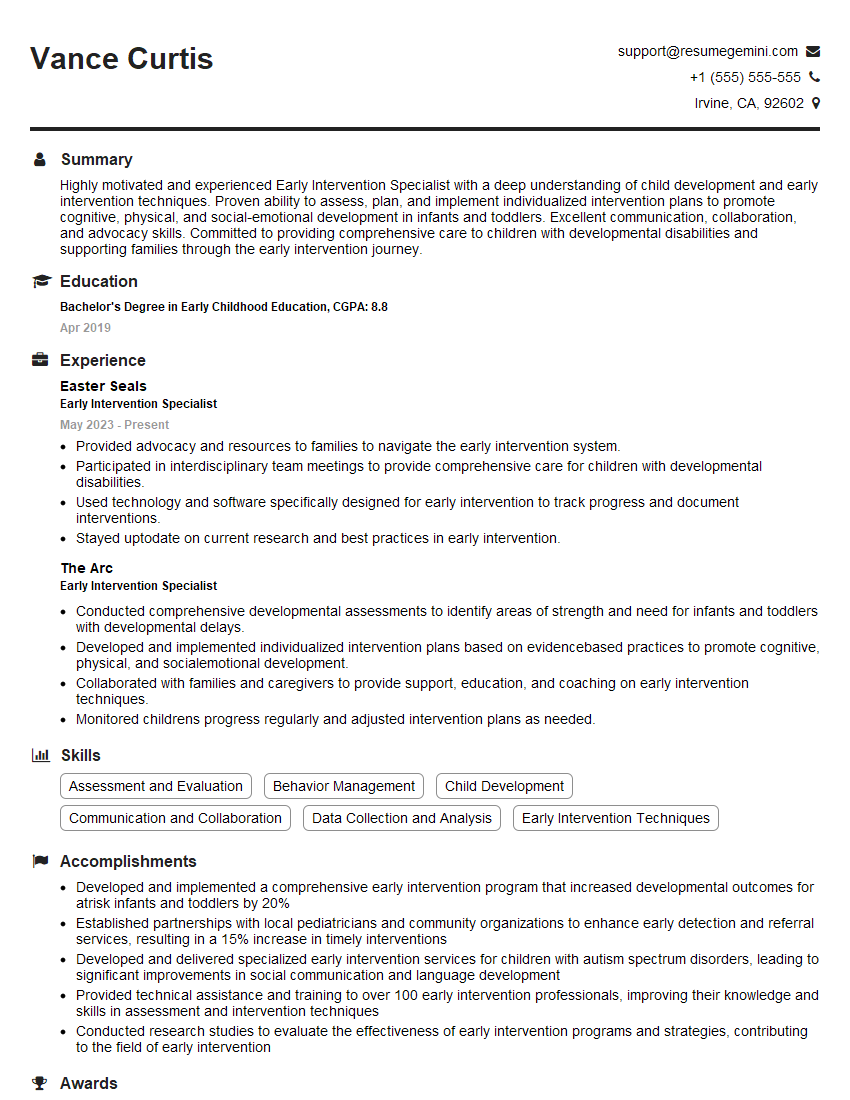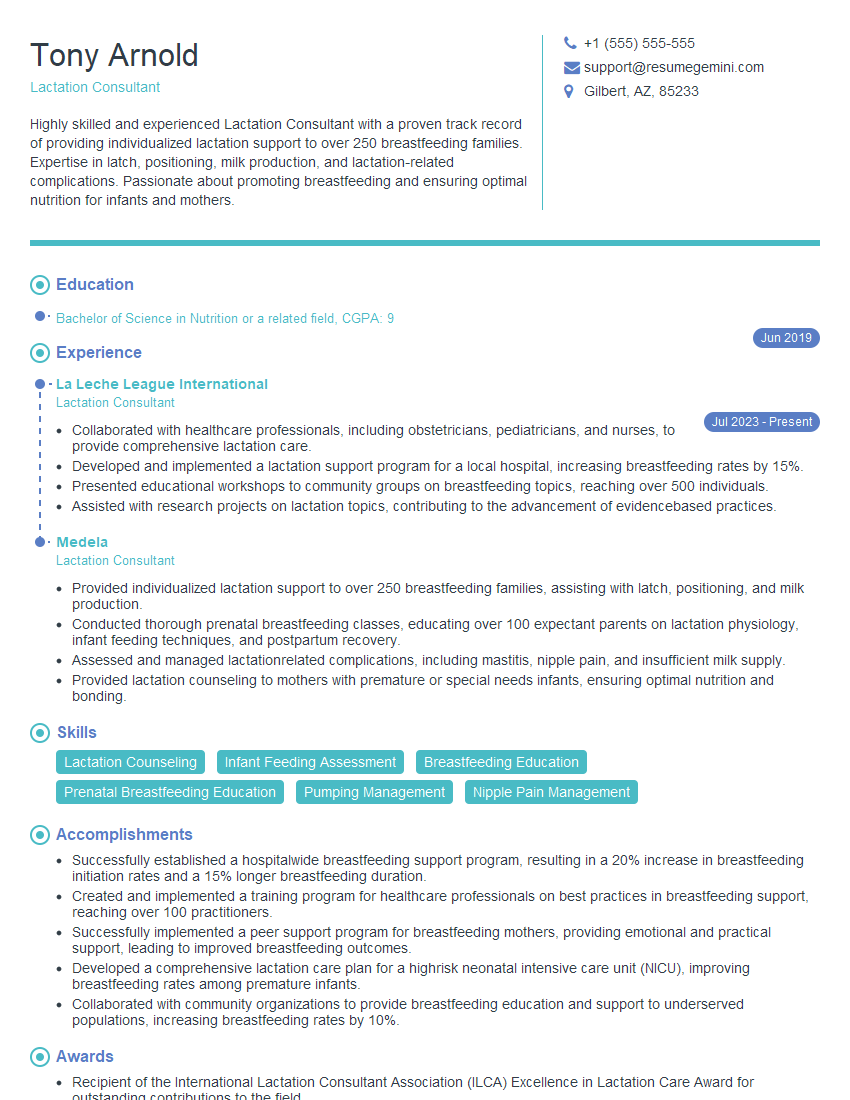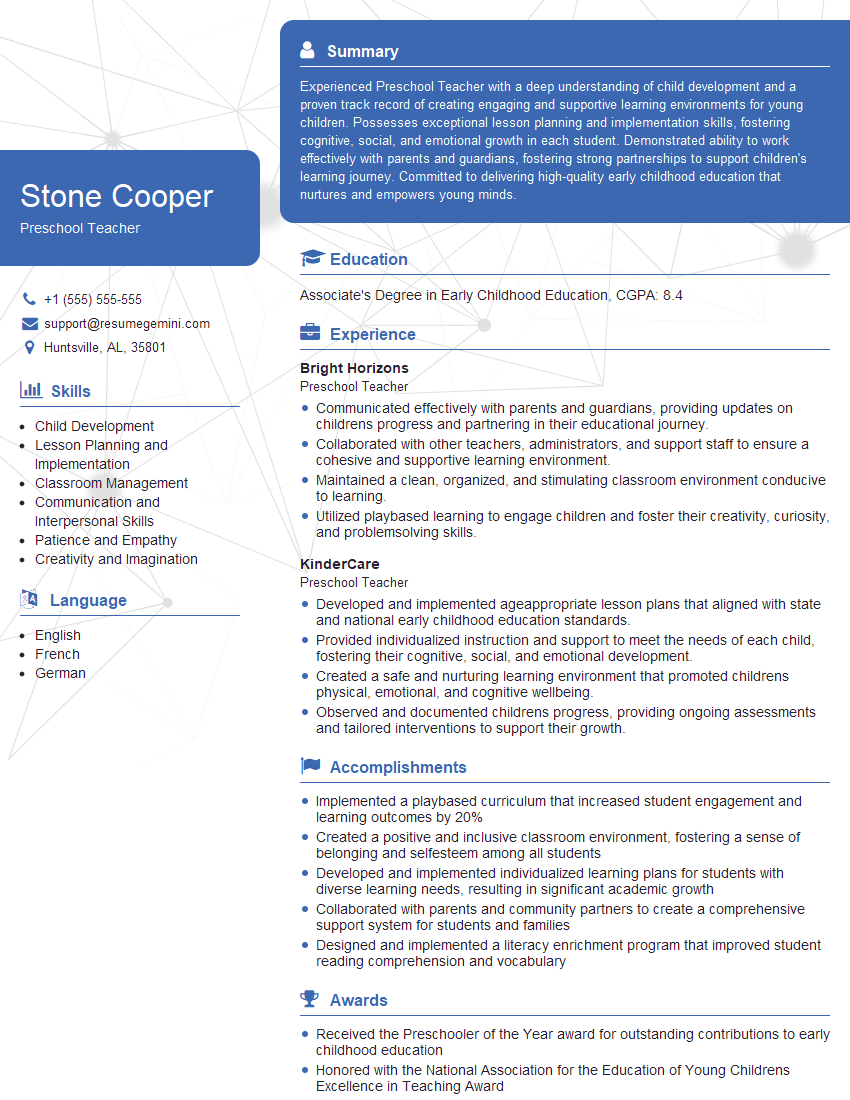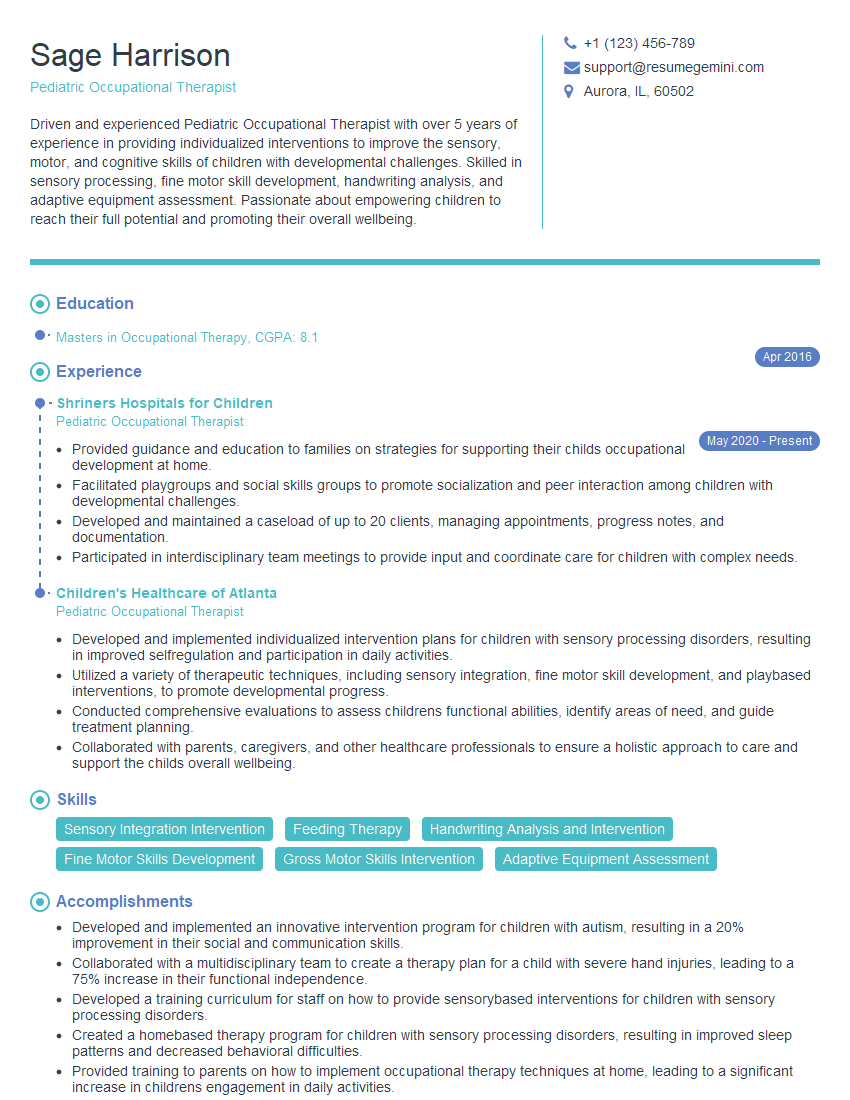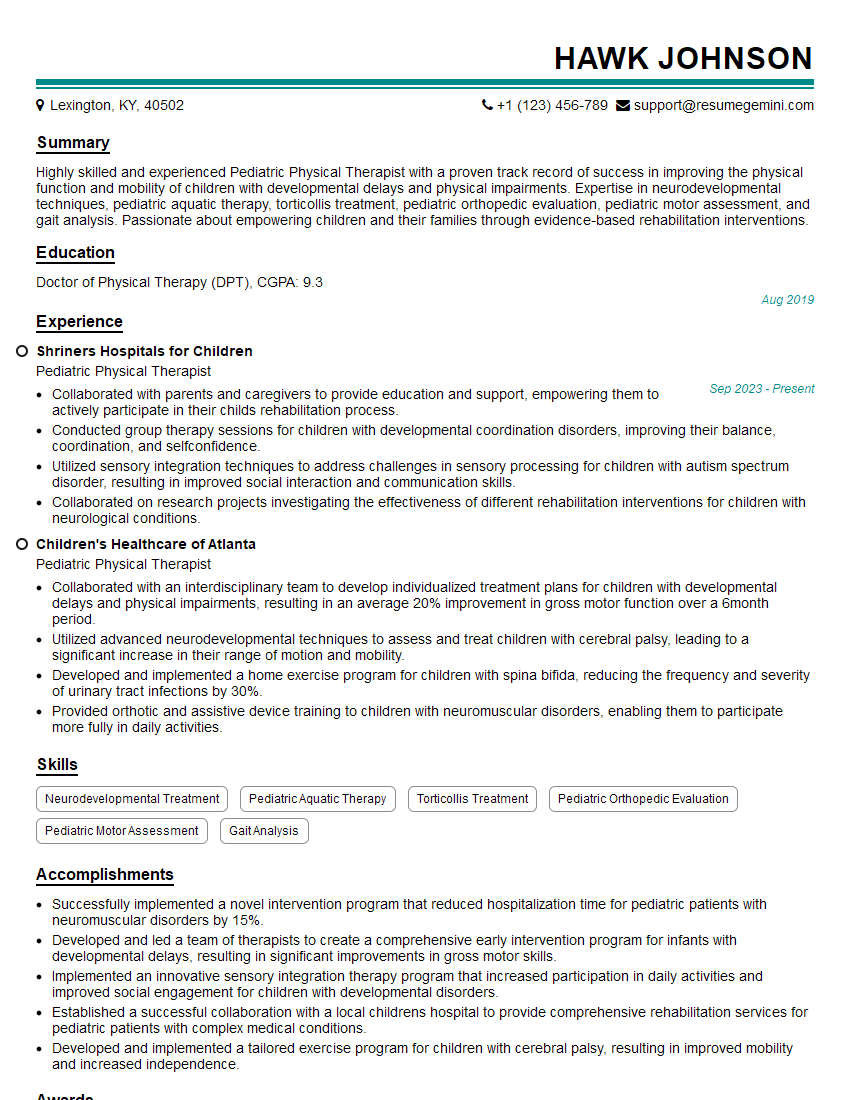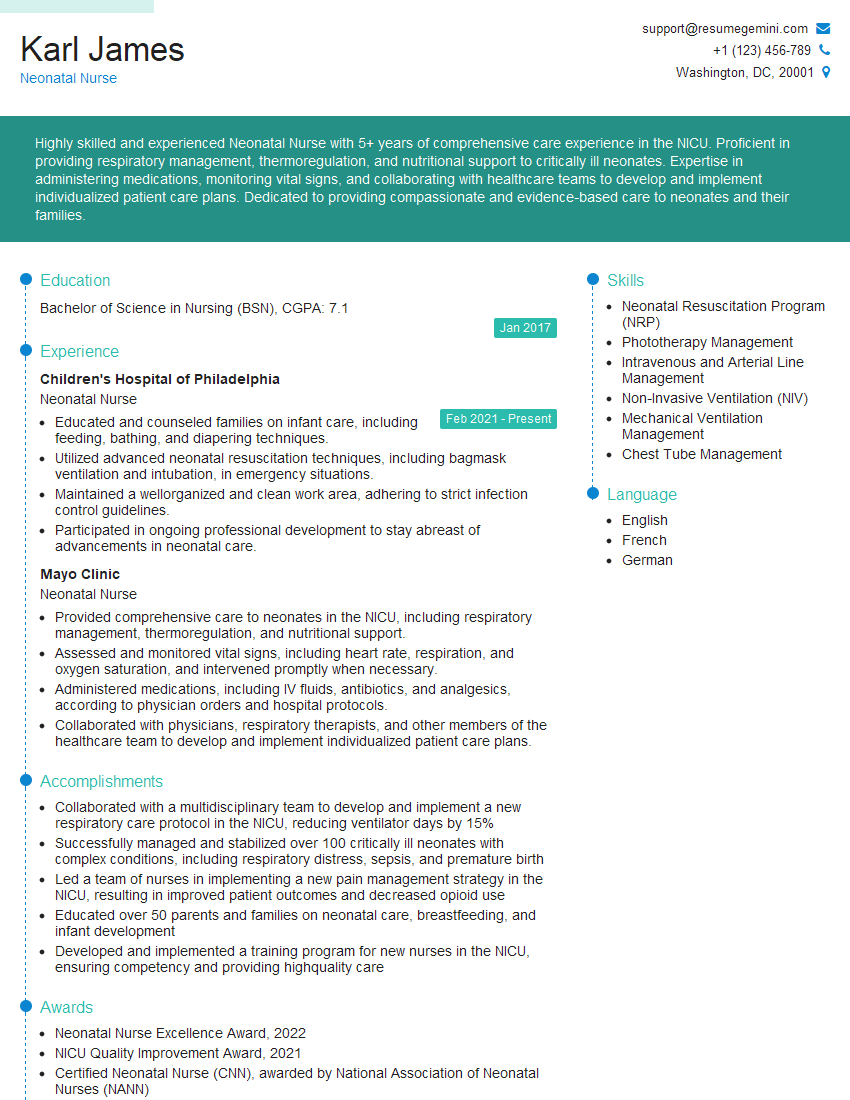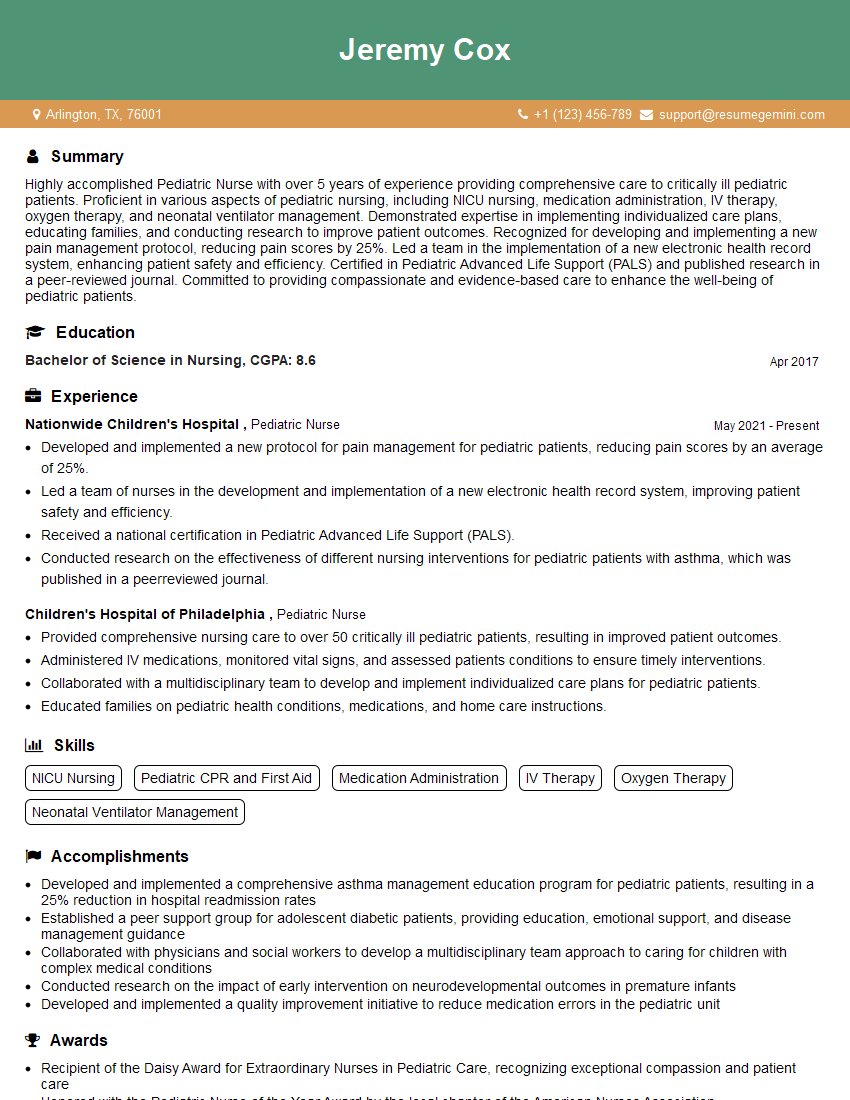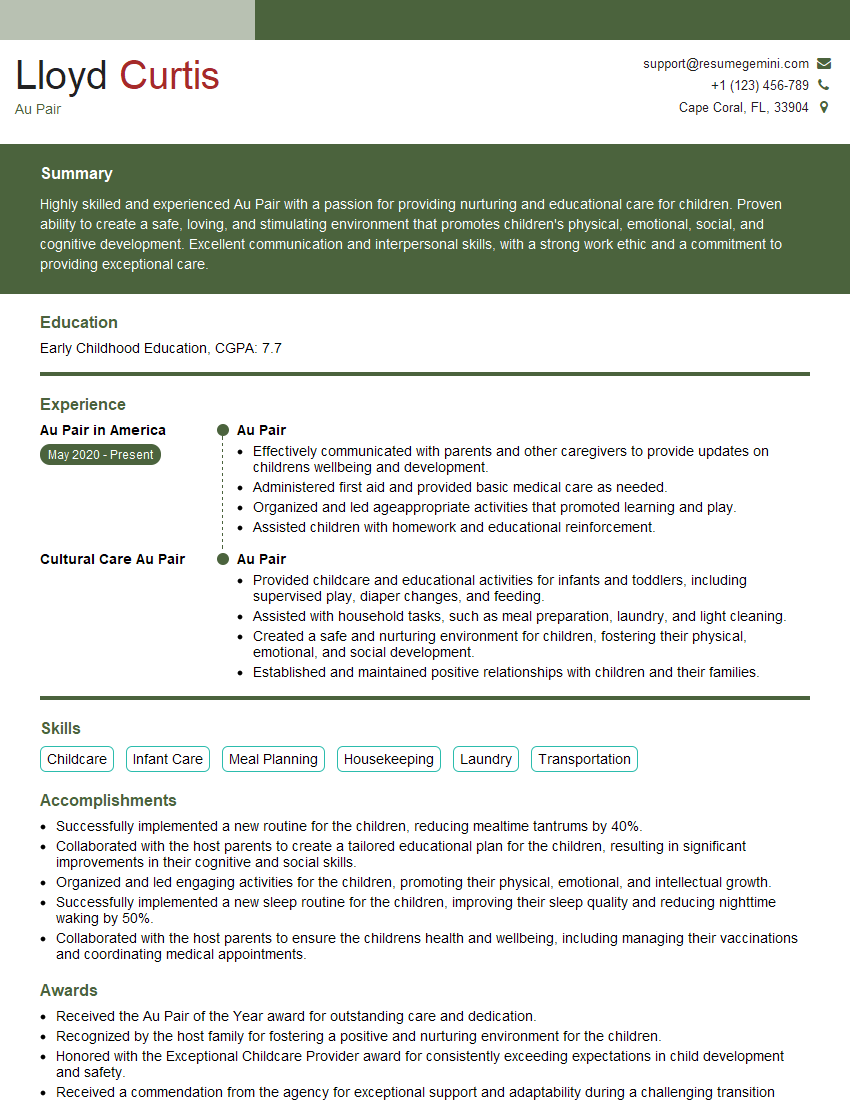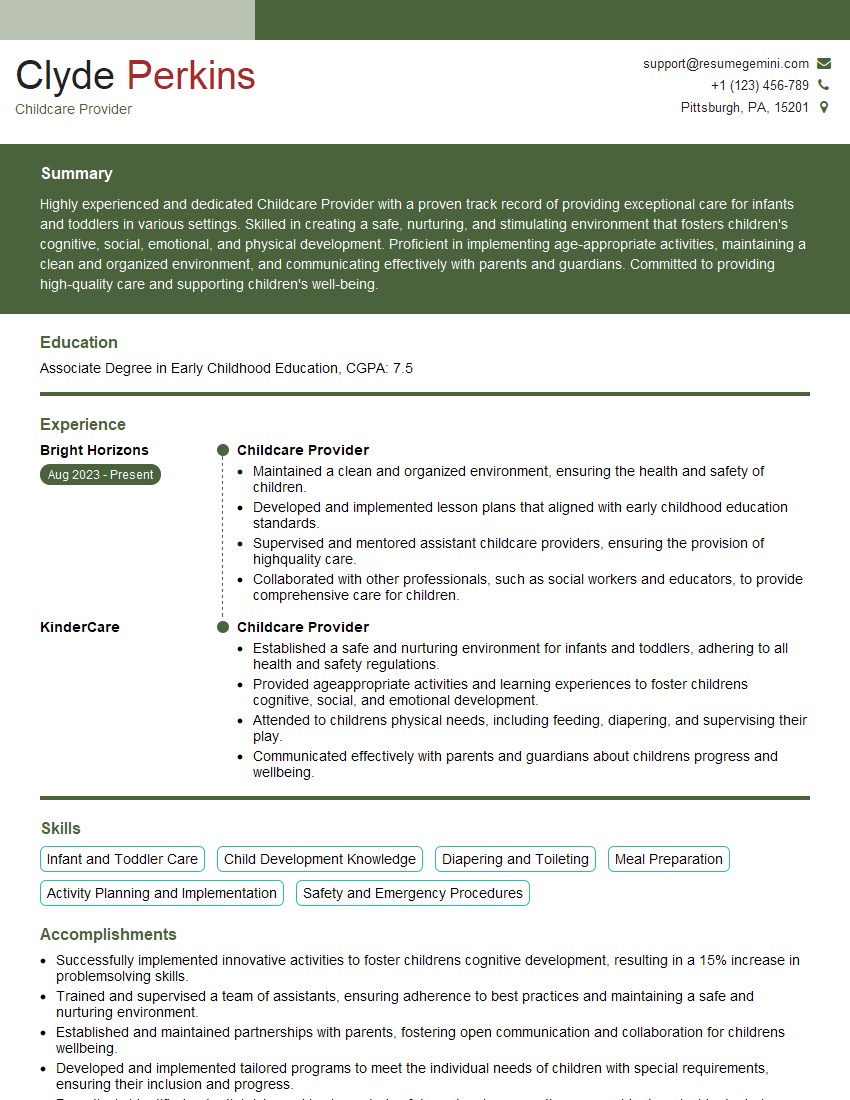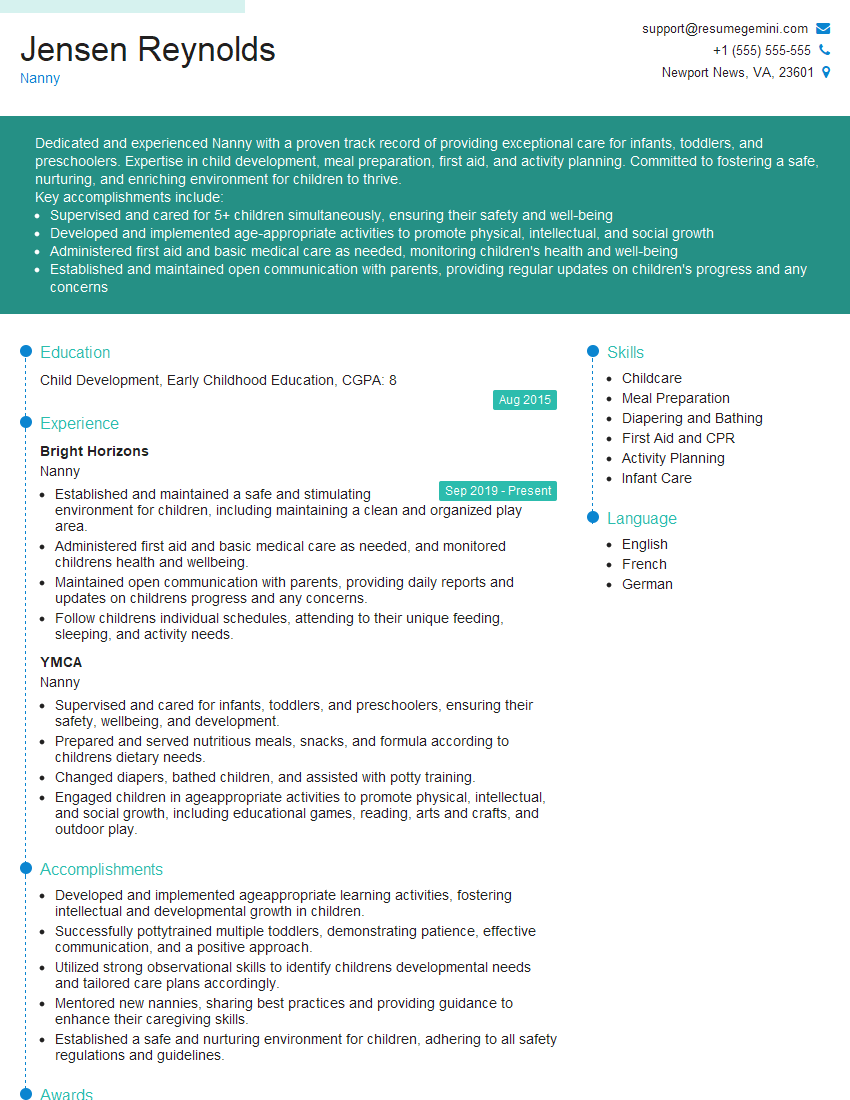The thought of an interview can be nerve-wracking, but the right preparation can make all the difference. Explore this comprehensive guide to Infant Development and Care interview questions and gain the confidence you need to showcase your abilities and secure the role.
Questions Asked in Infant Development and Care Interview
Q 1. Describe the key developmental milestones in the first year of life.
Infant development in the first year is a period of incredible growth and change, marked by significant milestones across various domains. These milestones are not strictly rigid timelines, as individual variations exist, but serve as valuable guides.
- Gross Motor Skills: This refers to large muscle movements. Expect to see head control (around 2-4 months), rolling over (4-6 months), sitting unsupported (6-8 months), crawling (7-10 months), pulling to stand (8-12 months), and possibly even taking first steps (around 12 months).
- Fine Motor Skills: These involve small muscle movements. Watch for reaching and grasping (3-4 months), transferring objects between hands (4-6 months), pincer grasp (using thumb and forefinger – around 9 months), and exploring objects with increasing dexterity.
- Cognitive Development: This encompasses learning and problem-solving. Expect improvements in attention span, object permanence (understanding that an object still exists even when out of sight – around 8 months), and basic cause-and-effect understanding.
- Language Development: This includes communication skills. Listen for cooing and babbling (2-6 months), understanding simple words (6-12 months), and potentially saying first words (around 12 months).
- Social-Emotional Development: This area focuses on interactions and emotional regulation. Look for smiling in response to faces (2 months), showing stranger anxiety (6-8 months), and developing attachment to primary caregivers.
For example, a baby might start crawling around 7 months, but another might not until 10 months. Both are within the normal range. Regular check-ups with a pediatrician allow for monitoring of development and addressing any concerns.
Q 2. Explain the importance of tummy time for infant development.
Tummy time is crucial for a baby’s development, fostering strength, coordination, and overall physical well-being. It’s not just about strengthening neck and shoulder muscles; it impacts many areas.
- Muscle Development: Tummy time strengthens muscles in the neck, shoulders, back, and arms, preparing the baby for rolling, crawling, and eventually walking. Think of it as their ‘gym’ time.
- Motor Skill Development: It improves coordination and balance, enhancing their ability to control their body movements.
- Sensory Development: Spending time on their tummy exposes babies to different perspectives and textures, stimulating their senses.
- Head Control: This is a crucial precursor to many other developmental milestones, from sitting to crawling.
- Cognitive Development: The varied experiences during tummy time enhance cognitive development and problem-solving skills as they navigate their environment.
Remember to always supervise your baby during tummy time and provide short, frequent sessions to avoid fatigue. Start with a few minutes at a time, gradually increasing the duration.
Q 3. What are the signs of potential developmental delays in infants?
Developmental delays manifest differently in each child, but some common red flags warrant professional attention. These are not definitive diagnoses but rather indicators needing further investigation.
- Significant delays in reaching major milestones: For example, not rolling over by 6 months, not sitting unsupported by 9 months, or not walking by 15 months (these are approximate ages).
- Limited social interaction: Lack of eye contact, poor response to name, or not engaging with caregivers.
- Regression: Loss of previously acquired skills (e.g., stopping babbling, losing head control).
- Difficulty feeding or swallowing: Prolonged difficulties with breastfeeding or bottle feeding, or choking frequently.
- Motor skill challenges: Excessive floppiness or rigidity in limbs, difficulty grasping objects, or lack of coordination.
- Communication problems: Absence of babbling or gestures by 12 months, or significant delays in language comprehension or expression.
If you notice any of these signs, consult your pediatrician immediately. Early intervention is key to addressing potential developmental delays effectively. Don’t hesitate; it’s always better to be proactive.
Q 4. How would you respond to a crying infant?
Responding to a crying infant requires a calm, systematic approach. It’s crucial to understand that crying is the primary way infants communicate their needs.
- Assess the Situation: First, determine if the baby is wet, hungry, tired, or uncomfortable (too hot or cold). Addressing these basic needs is often the most effective solution.
- Comforting Techniques: Try swaddling, rocking, singing, or offering a pacifier. Skin-to-skin contact can be incredibly soothing.
- Rule out medical causes: If the crying is excessive, inconsolable, or accompanied by other symptoms (fever, lethargy), seek immediate medical attention.
- Respond Consistently: Respond promptly and consistently to your baby’s cries to build trust and security. This does not mean spoiling the child, but establishing a strong caregiver-infant bond.
- Patience and Self-Care: Caring for a crying baby can be emotionally draining. Take breaks when needed and seek support from family members or other caregivers.
For example, if a baby cries while feeding, it could be a sign of discomfort from gas, an improper latch, or insufficient milk flow. If the crying persists after addressing basic needs, consult a healthcare professional.
Q 5. Describe safe sleep practices for infants.
Safe sleep practices are paramount to reducing the risk of sudden infant death syndrome (SIDS). Following these guidelines is crucial.
- Back to Sleep: Always place your baby on their back to sleep on a firm, flat surface.
- Bare is Best: Avoid using loose bedding, blankets, pillows, bumpers, or stuffed animals in the crib. These can create suffocation hazards.
- Room Sharing: Sleep in the same room as your baby for at least the first six months, ideally in the same bed but with safe sleeping arrangements (e.g., bed sharing co-sleeping done safely). This reduces the risk of SIDS.
- Breastfeeding: If possible, breastfeed exclusively for the first six months, and continue breastfeeding alongside solid foods for the first year. Breastfeeding is associated with reduced SIDS risk.
- Pacifier Use: If breastfeeding is established, consider offering a pacifier at bedtime or naptime after the first few weeks.
- Avoid Smoking and Alcohol: Exposure to secondhand smoke and alcohol can increase the risk of SIDS.
- Safe Crib Environment: Ensure the crib meets current safety standards, and there are no loose slats or gaps.
Safe sleep is about creating a low-risk sleeping environment. It’s a collective effort to prioritize baby’s health and wellbeing.
Q 6. What are the common feeding challenges faced by infants, and how would you address them?
Feeding challenges are common in infancy, ranging from latch difficulties to food allergies. Addressing these challenges effectively requires patience and professional guidance.
- Latch Difficulties (Breastfeeding): Proper latch is crucial. Lactation consultants can help assess and correct latch problems. Signs include pain during feeding, ineffective milk transfer, or nipple soreness. This is especially important in early weeks to avoid nipple trauma.
- Refusal to Feed: This could stem from illness, discomfort, or developmental changes. Observe for any other symptoms, and consult a pediatrician if concerned.
- Colic: Infants with colic cry excessively and often seem inconsolable. Methods like swaddling, rocking, and white noise may provide temporary relief. Medical consultation might be necessary for persistent colic.
- Food Allergies and Intolerances: Introducing solids should be done gradually to identify potential allergies or intolerances. Look for symptoms like rash, vomiting, diarrhea, or excessive fussiness after introducing a new food.
- Slow Weight Gain: Regular monitoring of weight gain is crucial. If weight gain is slow, medical intervention may be necessary to rule out underlying medical conditions.
Professional guidance from pediatricians, lactation consultants, and registered dietitians is beneficial to address any feeding concerns appropriately.
Q 7. How would you handle an infant who is experiencing separation anxiety?
Separation anxiety is a normal developmental phase, typically emerging around 6-8 months and peaking around 12-18 months. It signifies the infant’s growing awareness of themselves as separate from their caregivers.
- Gradual Separation: Start with short, controlled separations. For instance, leave the infant with a trusted caregiver for a few minutes and gradually increase the duration.
- Consistent Routine: Maintain a consistent daily routine to provide predictability and reduce anxiety.
- Familiar Objects: Allow the baby to bring a favorite blanket or toy for comfort when separated from parents.
- Positive Goodbyes: Make goodbyes brief and positive to avoid prolonging the anxiety.
- Reassurance: When the infant is distressed, provide gentle reassurance and comfort when reunited.
- Avoid Sneak Departures: This can increase anxiety. Always say goodbye clearly before leaving.
- Don’t Prolong the Goodbyes: Quick and calm goodbyes are less stressful.
Remember to be patient and supportive. Separation anxiety is a normal developmental stage, and with consistent strategies, it will likely diminish over time.
Q 8. What are the different types of infant reflexes, and what is their significance?
Infant reflexes are involuntary movements or actions performed by a baby in response to a specific stimulus. They are crucial for assessing neurological development and overall health. These reflexes typically disappear as the infant matures and develops voluntary control.
- Rooting Reflex: Triggered by stroking the cheek; the baby turns its head towards the touch, searching for a nipple. This aids in breastfeeding.
- Sucking Reflex: Initiated by touching the lips or placing something in the mouth; the baby automatically begins sucking. Essential for feeding.
- Moro Reflex (Startle Reflex): Evoked by a sudden noise or movement; the baby extends its arms and legs, then brings them back in. This reflex is believed to be a survival mechanism.
- Grasp Reflex: When an object is placed in the infant’s palm, they will grasp it tightly. This reflex helps the baby maintain contact with their caregiver.
- Stepping Reflex: When held upright with feet touching a surface, the baby will make stepping motions. This reflex prepares the baby for future locomotion.
- Babinski Reflex: Stroking the sole of the foot causes the toes to fan out and curl. This reflex helps assess the development of the nervous system.
The absence or unusual presence of these reflexes can indicate potential neurological issues, highlighting the importance of regular checkups with a pediatrician.
Q 9. Explain the importance of sensory stimulation for infant development.
Sensory stimulation is vital for healthy brain development in infants. It involves providing enriching experiences that engage the five senses – sight, hearing, touch, taste, and smell. This helps build neural connections, leading to improved cognitive, motor, and social-emotional skills.
For example, providing a variety of colorful toys stimulates visual development, while playing music or singing helps auditory development. Tactile stimulation through touch, textures, and different temperatures enhances sensory processing. Introducing age-appropriate tastes and smells expands their sensory world.
Think of the brain as a muscle; the more it’s engaged, the stronger it becomes. Sensory stimulation exercises this ‘muscle,’ leading to faster learning and improved adaptability throughout life.
Q 10. How would you create a stimulating and safe environment for infants?
Creating a stimulating and safe environment for infants requires careful consideration of their developmental needs and safety. The space should be engaging yet free from hazards.
- Safe Space: Ensure the environment is baby-proofed, removing any potential choking hazards, sharp objects, or anything that could cause injury. Secure furniture and electrical cords.
- Sensory Richness: Include age-appropriate toys with varying textures, colors, and sounds. Mobiles, soft toys, and rattles can be highly stimulating. Mirrors can also fascinate infants.
- Comfort and Security: Provide a comfortable and secure space for sleep, such as a crib or bassinet. Ensure the room is adequately lit and temperature-controlled.
- Interactive Elements: Incorporate interactive elements, such as playmats, sensory bags (filled with safe materials like rice or beans), or books with vibrant images and textures.
- Supervision: Always supervise infants closely, even in seemingly safe environments. Never leave them unattended.
Remember, a balanced approach ensures both stimulation and safety are prioritized.
Q 11. How do you ensure the safety and hygiene of infants under your care?
Ensuring the safety and hygiene of infants is paramount. It’s a multifaceted process that demands consistent vigilance and adherence to strict protocols.
- Hand Hygiene: Thorough handwashing with soap and water before and after any interaction with the baby is essential.
- Diaper Changing: Change diapers promptly and use clean surfaces. Dispose of soiled diapers properly to prevent the spread of germs.
- Sterilization: Sterilize bottles, pacifiers, and any other items that come into contact with the baby’s mouth.
- Cleanliness: Maintain a clean and organized environment to minimize the risk of infection. Regularly clean and disinfect surfaces.
- Infection Control: Be vigilant for signs of illness and follow protocols for isolating a sick infant. Maintain a safe distance from anyone who is unwell.
- Safe Sleeping Practices: Always place infants on their backs to sleep on a firm surface, free from loose bedding or toys.
Regular cleaning, careful handwashing, and consistent adherence to safety guidelines are key to preventing infections and ensuring a safe and healthy environment.
Q 12. Describe your experience with diaper changing and feeding techniques.
Diaper changing and feeding are fundamental aspects of infant care, requiring both skill and gentleness.
Diaper Changing: I follow a methodical approach ensuring hygiene and comfort. This includes laying the baby on a clean surface, removing the soiled diaper, cleaning the area gently with wipes or a washcloth, applying a fresh diaper, and then disposing of the soiled diaper properly. Always checking for diaper rash and taking appropriate measures if needed.
Feeding Techniques: My approach to feeding depends on whether the infant is breastfeeding or bottle-feeding. With breastfeeding, I ensure proper latch and positioning to promote comfort and effective feeding. For bottle-feeding, I check the temperature of the formula to ensure it’s safe, hold the baby securely, and burp the baby regularly to prevent gas. I always monitor the baby’s feeding cues, ensuring they’re not overfed or underfed.
My experience encompasses various feeding methods and I adapt my technique to the individual needs of each baby, always prioritizing safety, comfort, and the baby’s cues.
Q 13. What are your strategies for handling challenging behaviors in infants?
Infants communicate their needs and frustrations through crying and other behaviors. Addressing these requires patience and understanding.
- Identify the Cause: Observe the infant carefully to determine the root cause of the challenging behavior – hunger, discomfort, tiredness, or something else. Sometimes, it’s simply a need for comfort.
- Respond Appropriately: Address the identified need. If the baby is hungry, feed them. If tired, provide a quiet, dark space for sleep. If uncomfortable, change their diaper or adjust their clothing.
- Soothing Techniques: Use soothing techniques such as gentle rocking, singing lullabies, or skin-to-skin contact to calm the infant.
- Consistency: Maintain consistency in your responses. This helps the infant learn that their needs will be met and promotes a sense of security.
- Seek Professional Advice: If the challenging behavior persists or seems excessive, seek advice from a pediatrician or child development specialist to rule out any underlying medical or developmental issues.
Remember, consistency, patience, and careful observation are key to managing challenging infant behaviors effectively.
Q 14. How would you communicate with parents about their infant’s development and well-being?
Effective communication with parents is vital for ensuring the well-being and development of the infant. It involves regular updates, active listening, and a collaborative approach.
- Regular Updates: Provide parents with regular updates on the infant’s progress, including feeding patterns, sleeping habits, and any developmental milestones achieved.
- Open Communication: Encourage open communication by creating a safe space for parents to share concerns or ask questions.
- Active Listening: Actively listen to parents’ concerns and validate their feelings. Show empathy and understanding.
- Developmental Milestones: Discuss the infant’s developmental progress, highlighting achievements and addressing any areas of concern.
- Collaborative Approach: Work collaboratively with parents to develop a care plan that meets the individual needs of the infant.
- Documentation: Maintain detailed records of the infant’s care, progress, and any significant events. This serves as a valuable communication tool with parents.
Open, honest, and frequent communication build trust and ensure parents are actively involved in their child’s care.
Q 15. How familiar are you with different infant developmental screening tools?
I’m very familiar with a range of infant developmental screening tools. These tools are crucial for early identification of potential developmental delays or concerns. The choice of tool depends on the age of the infant and the specific areas being assessed. Some commonly used tools include the Ages and Stages Questionnaires (ASQ), the Denver Developmental Screening Test II (Denver II), and the Bayley Scales of Infant and Toddler Development.
- ASQ: This parent-reported questionnaire screens for developmental milestones across various domains like communication, gross motor skills, fine motor skills, problem-solving, and personal-social skills. It’s easy to administer and provides a valuable snapshot of the child’s development.
- Denver II: This is a clinician-administered test that assesses gross motor, fine motor-adaptive, language, and personal-social skills. It’s more structured than the ASQ and allows for direct observation.
- Bayley Scales: This comprehensive assessment is typically used for infants and toddlers with suspected developmental delays or disabilities. It provides a detailed evaluation across cognitive, language, motor, and socio-emotional domains.
My experience encompasses administering and interpreting results from these and other screening tools, understanding their limitations, and effectively communicating findings to parents and healthcare providers. Knowing which tool to select based on the infant’s age and the specific concerns is key to providing appropriate support.
Career Expert Tips:
- Ace those interviews! Prepare effectively by reviewing the Top 50 Most Common Interview Questions on ResumeGemini.
- Navigate your job search with confidence! Explore a wide range of Career Tips on ResumeGemini. Learn about common challenges and recommendations to overcome them.
- Craft the perfect resume! Master the Art of Resume Writing with ResumeGemini’s guide. Showcase your unique qualifications and achievements effectively.
- Don’t miss out on holiday savings! Build your dream resume with ResumeGemini’s ATS optimized templates.
Q 16. Describe your knowledge of infant CPR and first aid.
I am certified in infant CPR and First Aid. My training covers a range of life-threatening situations, including choking, breathing difficulties, and cardiac arrest. I understand the specific techniques required for infants, recognizing that their anatomy and physiology differ from adults. This includes proper hand placement for chest compressions, the correct ratio of compressions to breaths, and the importance of early intervention.
For example, the technique for clearing an airway obstruction in an infant is different than in an adult. The back blows and chest thrusts require specific hand placement and force to be effective without causing further injury. My training also emphasizes the importance of recognizing early warning signs of distress, such as changes in breathing, skin color, or level of responsiveness. I am proficient in assessing the situation, providing immediate care, and coordinating with emergency medical services when necessary. Regular refresher courses ensure my skills remain up-to-date and compliant with the latest guidelines.
Q 17. What are the early warning signs of Sudden Infant Death Syndrome (SIDS)?
Unfortunately, there aren’t definitive early warning signs for Sudden Infant Death Syndrome (SIDS). This is why safe sleep practices are so crucial. SIDS is a diagnosis of exclusion – meaning that after a thorough investigation, no other cause of death can be identified. However, certain factors are associated with an increased risk of SIDS, and vigilance around these factors is vital.
- Apnea (temporary pauses in breathing): While not a direct predictor, prolonged or frequent apnea episodes should be carefully monitored and reported to a healthcare provider.
- Weak or floppy muscle tone: This can be a subtle sign of underlying health issues and should be assessed by a professional.
- Changes in skin color: Sudden paleness or blueness of the skin should warrant immediate attention.
- Difficulty feeding or feeding poorly: This could indicate underlying health problems that increase SIDS risk.
It is critical to emphasize that the absence of these signs does not guarantee an absence of risk. Consistent adherence to safe sleep practices remains the best strategy to reduce the risk of SIDS.
Q 18. How would you ensure the nutritional needs of an infant are met?
Ensuring an infant’s nutritional needs are met is paramount for healthy growth and development. The optimal approach depends on the infant’s age and health status. For newborns, exclusive breastfeeding for the first six months is recommended by the World Health Organization. This provides ideal nutrition and antibodies to protect against infections.
For infants who are not breastfed, iron-fortified infant formula is a suitable alternative. Introducing solid foods typically begins around six months, with age-appropriate foods introduced gradually to prevent allergies and ensure adequate nutrient intake.
Monitoring growth, checking weight and height regularly, and assessing the infant’s overall feeding patterns are key. I always work with parents to develop an individualized feeding plan, considering factors such as the infant’s appetite, tolerance, and any allergies. Addressing any feeding difficulties promptly is critical, as poor nutrition can negatively affect growth and development. For example, if an infant is struggling to latch, I would work with a lactation consultant to address breastfeeding challenges or explore alternatives while providing reassuring and empathetic support to the parents.
Q 19. What is your experience working with infants with special needs?
I have extensive experience working with infants with special needs. My experience includes working with infants diagnosed with a wide range of conditions, including Down syndrome, Cerebral Palsy, prematurity, and various genetic disorders. My approach is always individualized and family-centered.
It involves working collaboratively with a multidisciplinary team, including pediatricians, therapists, and other specialists. Early intervention is crucial, and I am skilled in assessing developmental delays and tailoring interventions to meet the unique needs of each infant. I’m adept at adapting activities and routines to promote optimal development. This might involve specialized feeding techniques for infants with swallowing difficulties or modified play activities to stimulate development in specific areas. A vital aspect is providing consistent support and guidance to families, fostering their confidence in caring for their infants and assisting them in accessing the resources they need.
Q 20. Explain your understanding of attachment theory and its relevance to infant care.
Attachment theory, developed by John Bowlby and Mary Ainsworth, describes the deep and enduring emotional bond between an infant and their primary caregiver. A secure attachment, characterized by trust and confidence, is crucial for the infant’s social, emotional, and cognitive development.
Infants develop different attachment styles based on the consistency and responsiveness of their caregivers. A secure attachment forms when caregivers are consistently sensitive and responsive to the infant’s cues, providing comfort and security. Insecure attachments, such as anxious-ambivalent or avoidant attachments, can arise when caregivers are inconsistent, neglectful, or emotionally unavailable.
Understanding attachment theory is central to infant care because it highlights the importance of providing a nurturing and responsive environment. Building a strong and secure attachment relationship sets the foundation for the infant’s future relationships and overall well-being. For example, recognizing an infant’s distress cues and responding promptly with comfort strengthens the attachment bond. Conversely, dismissing an infant’s cries or needs can contribute to insecure attachment.
Q 21. How would you promote positive parent-child interactions?
Promoting positive parent-child interactions is a cornerstone of healthy infant development. It involves fostering a warm, loving, and responsive relationship between the parent and the infant.
My approach includes educating parents about infant development, demonstrating effective communication strategies, and encouraging responsive parenting. This means being attuned to the infant’s cues, responding to their needs promptly, and engaging in playful interactions. For example, I’d encourage parents to engage in skin-to-skin contact, talk and sing to their infants, and respond to their attempts at communication. I’d also emphasize the importance of creating a nurturing and stimulating environment that supports exploration and learning.
Techniques like babywearing, massage, and tummy time not only promote physical development but also strengthen the parent-infant bond. Finally, I would offer ongoing support and encouragement, creating a space for parents to share their concerns and receive guidance. Remember, building a strong parent-child bond is an ongoing process that requires understanding, patience, and consistent effort.
Q 22. Describe your approach to handling accidents involving infants.
My approach to handling infant accidents prioritizes safety, assessment, and documentation. First, I ensure the infant’s immediate safety. This might involve removing them from a hazardous situation, providing comfort, and preventing further injury. Then, I carefully assess the extent of the injury. Minor scrapes and bumps require cleaning and observation for signs of infection. More serious incidents, such as falls or head injuries, necessitate immediate medical attention. I’ll contact parents/guardians and emergency services as needed. Throughout this process, meticulous documentation is crucial. This includes the time of the accident, the nature of the incident, the actions taken, and the infant’s response. For example, if a baby falls from a changing table, I’d document the height of the fall, the surface the baby landed on, any visible injuries, the steps I took to assess and comfort the baby, and when and how I contacted the parent and/or medical professional. This detailed documentation is essential for both the safety and well-being of the infant and to protect myself professionally.
Q 23. How would you deal with a situation where an infant is exhibiting signs of illness?
Recognizing signs of illness in infants requires vigilance. I’m trained to identify symptoms like fever (rectal temperature above 100.4°F), lethargy, poor feeding, vomiting, diarrhea, rash, or respiratory distress. My first step is to accurately assess the infant’s condition. This includes checking vital signs (temperature, heart rate, respiratory rate), observing their behavior and activity level, and noting any specific symptoms. Next, I’ll isolate the infant to prevent the spread of any potential infection. I’ll promptly inform the parents/guardians about the symptoms and recommend seeking medical advice. If the situation is critical – for instance, if the infant is exhibiting signs of respiratory distress or severe dehydration – I will immediately call emergency services. For example, if a baby displays a high fever and refuses to feed, I’ll immediately check their temperature, note the other symptoms, call the parents to inform them and seek medical attention. I also ensure I maintain detailed records of the infant’s symptoms, the steps I took, and any communication with parents and medical professionals.
Q 24. What are your strategies for managing multiple infants simultaneously?
Managing multiple infants requires efficient organization and a proactive approach. I use a combination of strategies to ensure each infant receives adequate care. This includes a well-structured daily schedule that includes feeding, diaper changes, playtime, and sleep. I utilize visual aids, such as checklists and charts, to track individual needs and progress. I incorporate routines and predictability for each child so they can feel secure. For example, a consistent nap routine helps promote healthy sleep. Prioritizing tasks based on urgency is also essential; a crying infant always takes precedence over a less pressing task. However, I aim to create a nurturing and calm environment for all the infants. Creating this balance prevents the feeling of rushing and ensures the quality of care is not compromised. Regular communication with colleagues is also a part of my approach for ensuring successful simultaneous care.
Q 25. What is your understanding of infant sleep patterns and how to promote healthy sleep habits?
Infant sleep patterns are dynamic and vary considerably. Newborns often sleep in shorter bursts throughout the day and night, gradually transitioning to longer sleep periods as they grow. Understanding these patterns is key to promoting healthy sleep habits. I educate parents about the importance of establishing a consistent bedtime routine, creating a calming sleep environment (dark, quiet, and cool), and swaddling for younger infants. Recognizing cues of sleepiness – such as rubbing eyes or yawning – is crucial for timely bedtime. Avoiding overstimulation before bed is also important. Safe sleep practices are paramount, with infants sleeping on their backs on firm surfaces without loose bedding or toys. It’s also important to be mindful of the impact of their surroundings. For example, we need to be mindful of noises, levels of light, and even the temperature to provide a soothing and restful sleep environment for the baby. Individual differences should also be respected; some infants may naturally be more wakeful than others, and adjustments to routines may be needed.
Q 26. How do you adapt your caregiving strategies to the individual needs of each infant?
Adapting caregiving strategies to individual needs is central to my practice. Infants have unique personalities, temperaments, and developmental trajectories. I observe each infant carefully to understand their individual cues, preferences, and responses. Some infants may prefer being rocked to sleep, while others might settle better with a pacifier. Some may require more frequent feedings than others. I utilize individualized feeding plans, considering the infant’s weight gain and feeding patterns. I use developmental milestones as a guideline to tailor activities and play sessions. For example, a baby who shows an interest in grasping will be provided with appropriate toys. This personalized approach fosters a strong bond and promotes the infant’s optimal development. Regular communication with parents is vital to gather insights into the infant’s home life and routines, allowing me to provide even more tailored care.
Q 27. Describe your experience with different childcare philosophies and approaches.
My experience encompasses various childcare philosophies, including attachment parenting, Montessori, and Reggio Emilia approaches. Attachment parenting emphasizes the importance of responsive caregiving and building a strong parent-child bond. I understand how this influences the creation of a secure base for the infant. The Montessori approach focuses on providing a prepared environment that fosters independence and self-directed learning. Reggio Emilia emphasizes collaboration between the caregiver, child, and family in creating a project-based learning environment. Understanding these different approaches enables me to adapt my caregiving style to meet the preferences and values of each family while still meeting the overall developmental needs of the infant. I believe that a blended approach, drawing on the best aspects of different philosophies, often yields the most beneficial outcomes.
Q 28. How do you maintain confidentiality and comply with relevant regulations in infant care?
Maintaining confidentiality and complying with regulations are paramount. I strictly adhere to all relevant privacy laws and regulations, such as HIPAA (in applicable settings). I never discuss infants’ information with unauthorized individuals and ensure all records are stored securely. I use coded identifiers rather than names whenever possible in documentation and communication. Parent permission is always obtained before sharing any information with others, and I follow clear protocols for reporting suspected child abuse or neglect. For example, I would never leave any sensitive information, such as medical records or family details, visible or accessible to unauthorized persons. My commitment to confidentiality is unwavering, ensuring the safety and security of the infants and their families.
Key Topics to Learn for Your Infant Development and Care Interview
- Physical Development: Understanding milestones in motor skills (gross and fine), sensory development, and nutritional needs. Consider practical applications like adapting activities to a child’s developmental stage and recognizing signs of developmental delays.
- Cognitive Development: Exploring Piaget’s stages of cognitive development, language acquisition, and early learning strategies. Think about how to create stimulating and age-appropriate learning environments and engage infants effectively.
- Social-Emotional Development: Learning about attachment theory, emotional regulation in infants, and the role of social interaction. Prepare examples of how you would nurture positive relationships with infants and respond to their emotional needs.
- Infant Safety and Health: Mastering safe sleep practices, recognizing signs of illness, and understanding basic first aid for infants. Be ready to discuss procedures for preventing accidents and responding to emergencies.
- Communication and Collaboration: Discuss strategies for effective communication with parents and other caregivers, teamwork in a childcare setting, and the importance of observation and documentation.
- Ethical Considerations: Review ethical guidelines related to confidentiality, child protection, and professional boundaries in infant care.
Next Steps
Mastering Infant Development and Care opens doors to rewarding careers with significant impact. A strong understanding of these key areas will significantly boost your interview performance and set you apart from other candidates. To maximize your job prospects, focus on crafting a professional and ATS-friendly resume that highlights your skills and experience effectively. ResumeGemini is a trusted resource for building impactful resumes, and we provide examples specifically tailored to the Infant Development and Care field to help you showcase your qualifications. Take advantage of these resources to create a resume that truly reflects your expertise and helps you land your dream job.
Explore more articles
Users Rating of Our Blogs
Share Your Experience
We value your feedback! Please rate our content and share your thoughts (optional).
What Readers Say About Our Blog
This was kind of a unique content I found around the specialized skills. Very helpful questions and good detailed answers.
Very Helpful blog, thank you Interviewgemini team.
